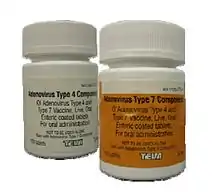Adenovirus vaccine
An adenovirus vaccine is a vaccine against adenovirus infection.[1]
 Bottles of the vaccine | |
| Vaccine description | |
|---|---|
| Target | Adenovirus |
| Vaccine type | Live virus |
| Clinical data | |
| AHFS/Drugs.com | Monograph |
| License data | |
| Routes of administration | By mouth |
| Identifiers | |
| UNII | |
It was used by the United States military from 1971 to 1999, but was discontinued when the only manufacturer stopped production.[2][3] This vaccine elicited immunity to adenovirus serotypes 4 and 7,[4] the serotypes most often associated with acute respiratory disease. On March 16, 2011, the U.S. Food and Drug Administration approved an adenovirus vaccine manufactured by Teva Pharmaceuticals under contract to the U.S. Army.[5] This vaccine is essentially the same as the one used from 1971 to 1999. On October 24, 2011, the military services began administering the new adenovirus vaccine to recruits during basic training.[6]
The vaccine is orally administered and consists of live (not attenuated) virus. The tablets are coated, so that the virus passes the stomach and infects the intestines, where the immune response is raised.[7]
It should not be confused with the strategy of using adenovirus as a viral vector to develop vaccines for other pathogens, or as a general gene carrier.[8][9][10]
References
- Tucker SN, Tingley DW, Scallan CD (February 2008). "Oral adenoviral-based vaccines: historical perspective and future opportunity". Expert Rev Vaccines. 7 (1): 25–31. doi:10.1586/14760584.7.1.25. PMID 18251691. S2CID 7058518.
- Russell KL, Hawksworth AW, Ryan MA, et al. (April 2006). "Vaccine-preventable adenoviral respiratory illness in US military recruits, 1999-2004". Vaccine. 24 (15): 2835–42. doi:10.1016/j.vaccine.2005.12.062. PMC 1955759. PMID 16480793.
- "Vaccine Trials For "Boot Camp Crud" May Help 20 Percent of Recruits". Archived from the original on 12 February 2009. Retrieved 15 January 2009.
- Centers for Disease Control and Prevention (CDC) (July 2001). "Two fatal cases of adenovirus-related illness in previously healthy young adults--Illinois, 2000". MMWR Morb. Mortal. Wkly. Rep. 50 (26): 553–5. PMID 11456329.
- Malarkey MA, Baylor NW. FDA approval letter dated March 16, 2011.
- Choudhry A, Mathena J, Albano JD, Yacovone M, Collins L (31 August 2016). "Safety evaluation of adenovirus type 4 and type 7 vaccine live, oral in military recruits". Vaccine. 34 (38): 4558–4564. doi:10.1016/j.vaccine.2016.07.033. PMID 27475474.
- Package insert for Adenovirus Type 4 and Type 7 Vaccine, Live, Oral, fda.gov, accessed 9 July 2020
- Croyle MA, Patel A, Tran KN, et al. (2008). Doolan DL (ed.). "Nasal Delivery of an Adenovirus-Based Vaccine Bypasses Pre-Existing Immunity to the Vaccine Carrier and Improves the Immune Response in Mice". PLOS ONE. 3 (10): e3548. Bibcode:2008PLoSO...3.3548C. doi:10.1371/journal.pone.0003548. PMC 2569416. PMID 18958172.
- Hartman ZC, Appledorn DM, Amalfitano A (March 2008). "Adenovirus vector induced innate immune responses: impact upon efficacy and toxicity in gene therapy and vaccine applications". Virus Res. 132 (1–2): 1–14. doi:10.1016/j.virusres.2007.10.005. PMC 4039020. PMID 18036698.
- Tatsis N, Ertl HC (October 2004). "Adenoviruses as vaccine vectors". Mol. Ther. 10 (4): 616–29. doi:10.1016/j.ymthe.2004.07.013. PMC 7106330. PMID 15451446.
External links
- "Adenovirus Vaccine Information Statement". U.S. Centers for Disease Control and Prevention (CDC). 8 January 2020.
- Adenovirus Vaccines at the US National Library of Medicine Medical Subject Headings (MeSH)